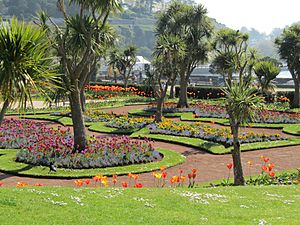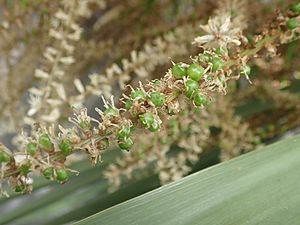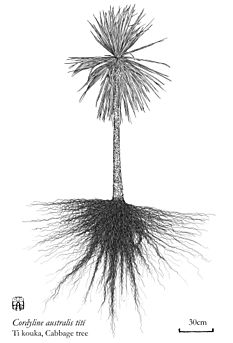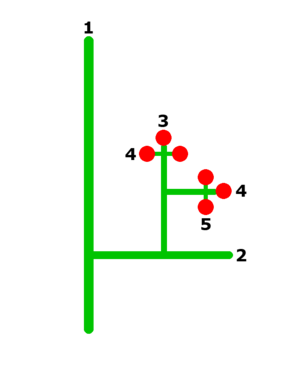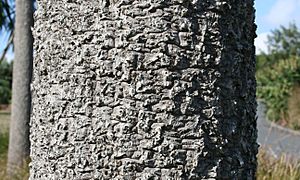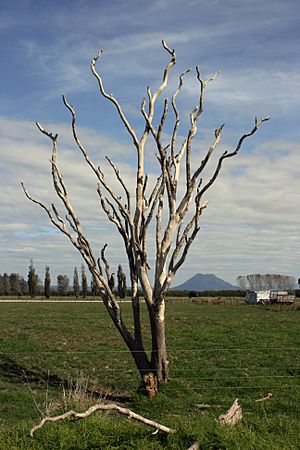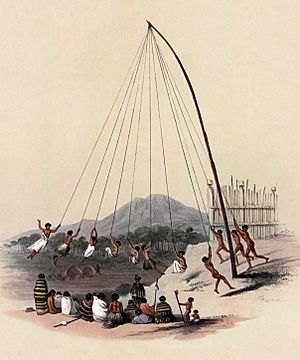Cabbage tree facts for kids
Quick facts for kids Cabbage tree |
|||||||||||
|---|---|---|---|---|---|---|---|---|---|---|---|
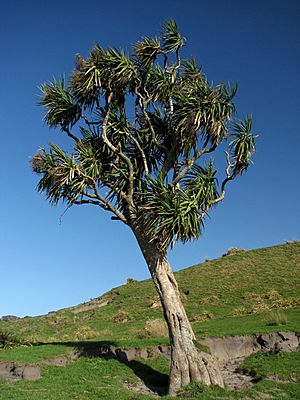 |
|||||||||||
| Cabbage tree on farmland, South Island, New Zealand | |||||||||||
| Scientific classification | |||||||||||
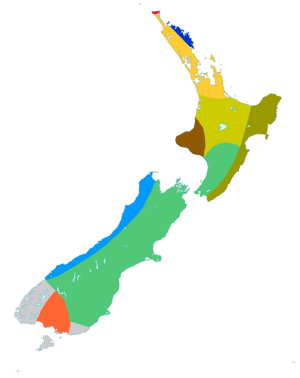 |
|||||||||||
C. australis varies by region in its natural range. Some variants have Māori names.
|
|||||||||||
The Cordyline australis, also known as the cabbage tree or tī kōuka, is a tree that grows only in New Zealand. It is a type of plant called a monocot, which means its seeds have one leaf.
This tree can grow up to 20 meters (about 65 feet) tall. It has a thick trunk and long, sword-like leaves. These leaves grow in bunches at the ends of its branches and can be up to 1 meter (about 3 feet) long. With its tall, straight trunk and round, leafy top, the cabbage tree is a common sight in New Zealand.
Its fruit is a favorite food for native birds like the New Zealand pigeon. You can find cabbage trees all over New Zealand, from the very north of the North Island to the south of the South Island. They grow in many places, like forest edges, riverbanks, and open areas. They are also common near swamps. The largest known cabbage tree with a single trunk is in Pakawau, Golden Bay. It is thought to be 400 or 500 years old. This giant tree is 17 meters (about 56 feet) tall and has a base that is 9 meters (about 30 feet) around.
The Māori call the tree tī kōuka. They used it as a food source, especially in the South Island, where other crops were hard to grow. The tree also provided strong fibers for textiles, ropes, fishing lines, baskets, and waterproof cloaks. Cabbage trees grow quickly and are tough. Because of this, they are often planted in New Zealand gardens, parks, and streets. Many different types (called cultivars) are available. These trees are also used in projects to bring back native plants, like on Tiritiri Matangi Island.
People also grow the cabbage tree as an ornamental plant in other countries with mild, wet climates. This includes parts of the United States, Canada, and the British Isles. In these places, it is sometimes called the Torbay palm or Torquay palm. It does not grow well in hot, tropical places like the Caribbean or Florida.
Contents
What the Cabbage Tree Looks Like
The Cordyline australis can grow up to 20 meters (about 65 feet) tall. Its trunk can be 1.5 to 2 meters (about 5 to 6.5 feet) wide. Before it flowers, the tree has a single, straight stem. It usually starts to flower when it is 6 to 10 years old, in the spring. Sometimes, if conditions are just right, it can flower as early as 3 years old.
After it flowers for the first time, the main stem splits. This creates a crown with many branches, each having a bunch of leaves at its tip. The bark is pale to dark gray, rough, and feels soft.
The leaves are long, narrow, and sword-shaped. They are dark to light green and are 40 to 100 centimeters (about 16 to 39 inches) long. They are 3 to 7 centimeters (about 1 to 3 inches) wide at the bottom. The leaves grow in crowded bunches at the ends of the branches. Older leaves might droop a little at their tips. They are thick and have many parallel veins.
In spring and early summer, the tree produces sweet-smelling flowers. These flowers grow in large, dense clusters called panicles, which can be 60 to 100 centimeters (about 2 to 3 feet) long. The individual flowers are small, about 5 to 6 millimeters (0.2 inches) across. The fruit is a white berry, 5 to 7 millimeters (0.2 to 0.3 inches) wide. Birds love to eat these berries. The flowers also attract many insects because of their nectar.
Under the ground, the plant has large, peg-like rhizomes. These are like thick roots covered with soft, purplish bark. They can grow up to 3 meters (about 10 feet) long in old plants. Rhizomes help to anchor the tree and store sugar.
Regional Differences in Cabbage Trees
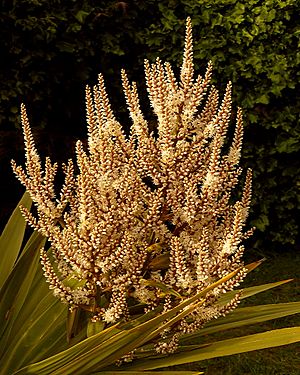
New Zealand's native Cordyline species are very old plants. They came from tropical areas about 15 million years ago. Because the C. australis has grown in different parts of New Zealand for so long, it looks a bit different depending on where it is. These differences can change the tree's overall shape, the size of its branches, and the shape, size, and color of its leaves. Some of these regional types were even given special names by the Māori in the North Island. For example, tītī in the north, tī manu in the central uplands, tarariki in the east, and wharanui in the west.
In the far north of New Zealand, some cabbage trees have floppy, narrow leaves. This might be because they have mixed with another type of cabbage tree called C. pumilio, the dwarf cabbage tree. In other parts of the north, some trees have much wider leaves. This could be from mixing with the Three Kings cabbage tree, C. obtecta.
In the central part of the North Island, cabbage trees are tall with thick, mostly unbranched stems and large, stiff leaves. These trees are thought to be good at handling the cold winters there. In the east of the North Island, you find tarariki trees. Their strong, spiky leaves were valued by Māori for making tough fibers. In the west, wharanui trees have long, broad, flexible leaves. This might help them deal with the strong westerly winds.
In the South Island, wharanui is the most common type, but it still varies. In some areas, like Marlborough, cabbage trees tend to keep their old, dead leaves, making them look a bit messy. This might be due to the very hot, dry summers and cold winters there. In the far south of the South Island, near Fiordland, the trees are very strong with broad, green leaves. They seem to be well-suited to the very cold winters.
Studies of young cabbage trees grown from seeds show that leaves get longer and narrower the further south they come from. Young plants also often have reddish-brown leaves, especially in the south. These changes in leaf shape and color suggest that the trees adapt to colder weather.
How Cabbage Trees Are Named
The Cordyline australis was first collected in 1769 by Sir Joseph Banks and Dr Daniel Solander. They were naturalists on Captain James Cook's ship, the Endeavour. They found it in Queen Charlotte Sound.
It was first named Dracaena australis in 1786 by Georg Forster. You might still see it sold as a Dracaena today, especially for house plants. In 1833, Stephan Endlicher moved the species to the genus Cordyline.
The name Cordyline comes from an Ancient Greek word meaning "club." This refers to the tree's thick underground stems. The word australis is Latin for "southern." The common name "cabbage tree" might come from early settlers using its young leaves like cabbage. However, the name might be older. Georg Forster wrote in 1777 about finding a similar plant in Fiordland. He said its central shoot tasted a bit like cabbage. He might have been thinking of the cabbage palmetto from Florida, which looks a bit like the Cordyline.
Cordyline australis is the tallest of New Zealand's five native Cordyline species. Other common types include C. banksii, which has a slender trunk, and C. indivisa, a beautiful plant with a large head of broad leaves. In the far north, C. australis can be told apart from its closest relative, C. obtecta, by its larger size and narrower leaves. Cabbage trees can also mix with other Cordyline species like C. pumilio and C. banksii if they grow close together and flower at the same time.
The tree was very important to the Māori long before scientists discovered it. The general Māori word for Cordyline plants is tī. Specific names for C. australis include tī kōuka, tī kāuka, and tī rākau. Different tribes had names for the tree based on how they used it or what it looked like. For example, tī rākau means a large tree, and tī tarariki means spiky. The most common name, tī kōuka, refers to using the leaf hearts as food.
Cabbage Tree Life and Habitat
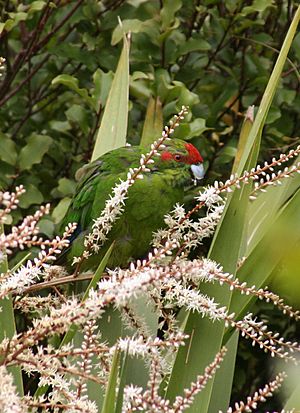
Where Cabbage Trees Live
Cabbage trees used to grow in many different places in early New Zealand. They were found in open, moist, fertile, and warm areas. This included forests, rocky coasts, swamps, and along rivers. When sailors approached New Zealand, the sight of these trees might have reminded them of tropical islands.
Cordyline australis grows from the very north to the very south of New Zealand. It is not found in most of Fiordland, probably because the habitat isn't right. It also doesn't grow on the subantarctic islands because it's too cold. It can be found on some offshore islands, but Māori likely brought it there.
This tree usually grows in lowlands, from sea level up to about 1000 meters (about 3,280 feet) high. It reaches its highest points on volcanoes in the central North Island, where eruptions created open spaces for it to grow. In the central North Island, it has developed a stronger form, called tī manu by Māori. This form looks similar to those in the far south of the South Island, suggesting they both adapted to cold conditions.
Cabbage trees need a lot of light to grow. Young plants will die if other trees grow over them and block the sun. They also need water when they are young. While adult trees can store water and handle dry periods, seedlings need a good water supply to survive. This is why they don't grow well in sand dunes or on dry hillsides. The soil also needs to be fertile. Early European settlers in Canterbury used the presence of cabbage trees to find good spots for their homes and gardens. The fallen leaves also help make the soil richer. Frost is another important factor. Young trees can be killed by frost, and even old trees can be damaged. This is why C. australis is not found in very cold inland areas.
Early European explorers described "jungles of cabbage trees" along rivers and in large swamps. Today, very few of these large groups of trees remain. These areas were often the first to be cleared by farmers looking for flat, fertile land. Now, cabbage trees usually grow alone, rather than as part of a large, healthy forest.
How Cabbage Trees Reproduce
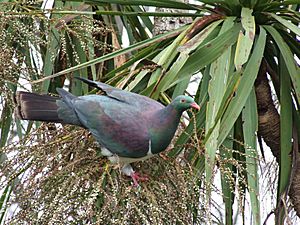
The cabbage tree's year starts in autumn. Inside the tight spike of unopened leaves at the center of each leaf bunch, some tips begin to form flowers for the next spring. These flowers and new leaf buds stay protected by the surrounding leaves during winter. In spring or early summer, the flowers appear on the outside of the tree, ready for insects and birds.
Flowering lasts for about four to six weeks, giving plenty of time for insects to pollinate them. The flowers have a sweet smell that attracts many insects. The nectar contains special compounds that moths especially like. Bees use the nectar to make light honey. It takes about two months for the fruit to ripen. By the end of summer, a cabbage tree can have thousands of small fruits for birds to eat and spread. The strong flower stalks can hold heavy birds like the New Zealand pigeon, which used to be the main way the seeds were spread.
Each fruit has three to six shiny, black seeds. These seeds are covered in a charcoal-like substance that might protect them from being digested by birds. The seeds are also rich in a special fat that helps the young plant grow and is important for birds laying eggs. Cabbage trees tend to flower heavily every other year, with a very big flowering season every three to five years. A large flower cluster can have 5,000 to 10,000 flowers, meaning one tree can produce a million seeds in a good year!
Plants and Animals Living with Cabbage Trees
Many plants and animals live with C. australis in healthy natural areas. Ferns, astelias, and orchids often grow on the tree itself. Old trees might have large clumps of climbing ferns. Other plants like mosses and fungi also grow on them. Two types of fungi that infect living tissue are found almost only on C. australis.
Animals and birds that live with cabbage trees include lizards, which look for food among the flowers. The gold-striped gecko is well hidden among the leaves. New Zealand bellbirds often build nests under dead leaves or among flower stalks. Red-crowned parakeets are often seen looking for food in cabbage trees. In South Canterbury, long-tailed bats hide in hollow branches during the day.
Birds like bellbirds, tui, and pigeons love the berries of C. australis. Māori sometimes planted groups of cabbage trees to attract pigeons, which they could then catch for food. As native birds have disappeared from many parts of New Zealand, flocks of starlings now often eat the fruit.
The flowers' nectar attracts insects, bellbirds, tui, and stitchbirds. The leaves and rough bark provide good homes for insects like caterpillars, moths, beetles, and wētā, as well as snails and slugs. Many of these insects are then eaten by birds like saddlebacks and robins. The rough bark also allows other plants to grow on it, and lizards hide among the dead leaves.
Insects, including beetles, moths, wasps, and flies, use the tree in different ways. Some feed on it, or hide in the skirt of dead leaves, which is a favorite dry spot for wētā in winter. Many insects that live with the tree have followed it into gardens and parks. If the leaves are left to decay, the soil under cabbage trees becomes rich and supports many small creatures like earthworms.
There are nine insect species found only on C. australis. The best known is the Epiphryne verriculata, which is perfectly camouflaged to hide on a dead leaf. Its caterpillars eat holes and notches in the leaves. The moth lays its eggs at the base of the central spike of unopened leaves. The caterpillars can infest young trees but usually don't harm older ones.
Threats to Cabbage Trees
Sudden Decline Disease
In 1987, sick and dying cabbage trees were first reported in the northern North Island. This problem, called Sudden Decline, quickly spread. Affected trees usually lose all their leaves within 2 to 12 months. The leaves turn yellow, then wither and fall off. New leaves stop growing, and eventually, all leaves fall, leaving dead branches. At the same time, the bark on the trunk becomes loose. The most affected areas were around Auckland, where 18 to 26 percent of trees died.
For some years, no one knew what caused the disease. People thought it might be old age, fungi, viruses, or even too much UV light. Another idea was that planting many cabbage trees from other regions in gardens might have caused a genetic problem. After almost five years of research, scientists found the cause: a bacterium called Phytoplasma australiense. This bacterium might be spread from tree to tree by a tiny sap-sucking insect called the introduced passion vine hopper.
Sudden Decline severely reduced the number of cabbage trees in some parts of New Zealand. In some northern areas, there are no big trees left. While Sudden Decline often affects trees in farmland and open areas, trees in natural forests continue to do well. Trees in the southern North Island and northern South Island are generally not affected. By 2010, there were signs that the disease was becoming less severe.
Rural Decline
The Sudden Decline epidemic also brought attention to another problem for cabbage trees in rural areas, called Rural Decline. This refers to older trees in pastures and grazed areas slowly becoming unhealthy, losing their upper branches, and eventually dying over many years.
Farmers often left single cabbage trees or even groups of trees standing after draining swamps. Most of these trees slowly die because farm animals eat the young seedlings and damage the trunks and roots of adult trees. If a cabbage tree is the only shade in a field, animals will shelter under it. They rub against the bark, damaging it, and compact the soil around the tree. Cows, sheep, goats, and deer eat the nutritious tissue under the bark. Once the trunk is damaged, it rarely heals, and the wounds get bigger. Eventually, the inside of the trunk rots away, forming a hollow space. The trunk can become misshapen or completely stripped of bark. This damage can lead to infections that spread into the branches, causing the tree's top to die. Other things that contribute to Rural Decline include wood-rotting fungi and leaf-eating caterpillars.
Other mammals can also cause damage. Possums usually don't eat the leaves, but they love to eat the sugary flowering stalks as they grow. They also like to sleep in the trees. Rabbits can be more destructive, especially during dry times. They have been seen eating through the base of a tree until it falls, then eating the entire fallen tree. Horses can also fell a tree by eating through its trunk.
Māori Uses of the Cabbage Tree
In the past, Māori knew a lot about the cabbage tree. This included its spiritual meaning, its role in nature, and many practical ways to use it. While much of this knowledge was lost after Europeans settled in New Zealand, the tree is still used for food and medicine. Its fibers are also becoming more commonly used for weaving again.
Cabbage Tree as Food
The stems and thick underground roots (rhizomes) of C. australis are full of natural sugars. Māori would steam-cook them in earth ovens (called umu tī or a large hāngi) to make kāuru. This was a food rich in carbohydrates, used to sweeten other foods. The growing tips or "hearts" of the leaves were stripped and eaten raw or cooked as a vegetable, called kōuka. This is where the Māori name for the tree comes from.
In the South Island, where kumara (sweet potato) was hard to grow, the cabbage tree became a very important food source. Natural and planted groups of cabbage trees were harvested. Large groups of people would trim the cut stems and leave them to dry for days or weeks. The rhizomes, which look like huge carrots underground, were also dug up to be cooked. Māori preferred rhizomes from trees growing in deep, rich soil. They dug them in spring or early summer, just before the plant flowered, when they were sweetest. November was the favorite month for preparing kāuru in the South Island.
After drying, the harvested stems or rhizomes were steamed for 24 hours or more in the umu tī pit. Steaming turned the sugar in the stems into a very sweet form called fructose. The cooked stems or rhizomes were then flattened by beating and taken back to villages for storage. Kāuru could be stored dry and later added to other foods to make them taste better. The sugar would be partly crystallized and mixed with other material between the root fibers. People could also dip kāuru in water and chew it. It was said to smell and taste like molasses.
You can still find evidence of large cooking pits (umu tī) in the hills of South Canterbury and North Otago, where many cabbage trees still grow. Europeans also used the plant to make alcohol.
The kōata, which is the growing tip of the plant, was eaten raw as medicine. When cooked, it was called kōuka. If you firmly grip and bend the spike of unopened leaves and a few outer leaves at the base, it will snap off. The leaves can be removed, and what's left is like a small artichoke heart. This can be steamed, roasted, or boiled to make kōuka, a slightly bitter vegetable available all year. Kōuka tastes great with fatty foods like eel or pigeons. Different trees were chosen for how bitter they were: very bitter for medicine, less bitter for eating.
Cabbage Tree Fibers
A strong fiber was taken from the leaves of C. australis. It was valued for its strength, especially in seawater. The leaves could be used for weaving as they were, without needing much processing. They were used to make anchor ropes, fishing lines, cooking mats, baskets, and sandals. They also made leggings for protection when traveling in the South Island's high country, which has prickly plants. Because the plant is water-resistant, the leaves were traditionally used for cooking baskets.
Morere swings were a fun activity for Māori children. The ropes for these swings had to be very strong. They were often made from the leaves or fiber of C. australis, which were much tougher than New Zealand flax fibers. The leaves were also used for rain capes, though the mountain cabbage tree (C. indivisa) was preferred for this.
Cabbage Tree in Medicine
The Māori used different parts of Cordyline australis to treat injuries and illnesses. They would boil parts to make a drink or pound them into a paste. The kōata, the growing tip, was eaten raw to help clean the blood. Juice from the leaves was used for cuts and sores. A drink made from the leaves was taken for diarrhea and used to wash cuts. The leaves were rubbed until soft and applied to cuts, skin cracks, or sore hands. Young shoots were eaten by nursing mothers and given to children for stomach pain. The liquid from boiled shoots was also taken for other stomach problems. The seeds of Cordyline australis are rich in a healthy fat called linoleic acid.
Growing Cabbage Trees Today
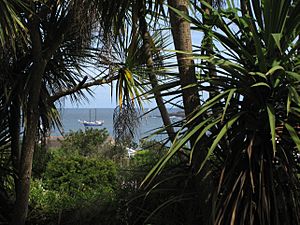
Cordyline australis is one of the most widely grown native New Zealand trees. In Northwest Europe and other cool, mild climates, it is very popular as an ornamental tree because it looks like a palm tree. Tougher types from the coldest parts of the southern or inland South Island grow best in Northern Hemisphere conditions. Types from the North Island are more sensitive to cold. It can also grow well in places with a Mediterranean climate.
It is easy to grow from fresh seeds. Young plants often pop up in gardens from seeds spread by birds. It can also be grown easily from cuttings of shoots, stems, and even trunks. It does well in pots and tubs.
It grows as far north as the eastern coast of Scotland. It is even more common in Southern England and Ireland, where it is grown all over the island. Although it's not a true palm, it's locally called Cornish palm, Manx palm, or Torbay palm. The last name comes from its widespread use in Torbay, where it is an official symbol used in tourist ads. It also grows in southern Europe, California, and Japan. Even though it naturally grows in warmer southern areas, it can even grow near the Arctic Circle in Norway, thanks to a special microclimate.
Different Types of Cabbage Trees (Cultivars)
In the North Island, Māori grew special types of C. australis for food. One of these, called tī para or tī tāwhiti, was grown because it easily produces many fleshy roots. This was a small, non-flowering type of C. australis with a soft, thick stem and green leaves. Although early naturalists wrote about it, botanists only found it again in the 1990s. Gardeners were growing it as a plant called Cordyline 'Thomas Kirk'. DNA studies suggest it came from C. australis in the central North Island.
Cordyline 'Ti Tawhiti' was once the subject of a big discussion among New Zealand botanists 100 years ago. It was saved from disappearing because its small size made it popular with gardeners. It became known as Cordyline 'Kirkii'. Its origin as a Māori-selected plant was forgotten until 1991. The name 'Tawhiti' is like 'Hawaiki', suggesting the traditional belief that Māori brought the plant to Aotearoa (New Zealand) in their canoes. However, it's more likely that the name came from it being moved around its native land as a farmed plant.
Many different types (cultivars) of C. australis are sold in New Zealand and around the world. Like other Cordyline species, C. australis can have natural changes that create very attractive colors. These include pink stripes and leaves in different shades of green, yellow, or red. An early type, 'Lentiginosa', was described in 1870 as having tinted leaves with brownish-red spots. Other early types had crimson midribs or purple leaves. There are also many types with mixed colors. In New Zealand and overseas, mixed types (hybrids) with other Cordyline species are very popular. Some colored types and hybrids in New Zealand seem to be more easily attacked by the cabbage tree moth.
Young cabbage trees have become popular as house or ornamental plants under the name 'Spikes' or Dracaena 'Spikes'. Sometimes, these are mistakenly identified as Cordyline indivisa.
C. australis can survive in USDA zones 8–11, meaning it can handle certain levels of cold.
Award-Winning Types
In the United Kingdom, the following types of C. australis have received the Royal Horticultural Society's Award of Garden Merit:
- C. australis
- 'Albertii'
- 'Sundance'
- 'Torbay Dazzler'
- 'Torbay Red' (confirmed 2017)
See also
 In Spanish: Cordyline australis para niños
In Spanish: Cordyline australis para niños


